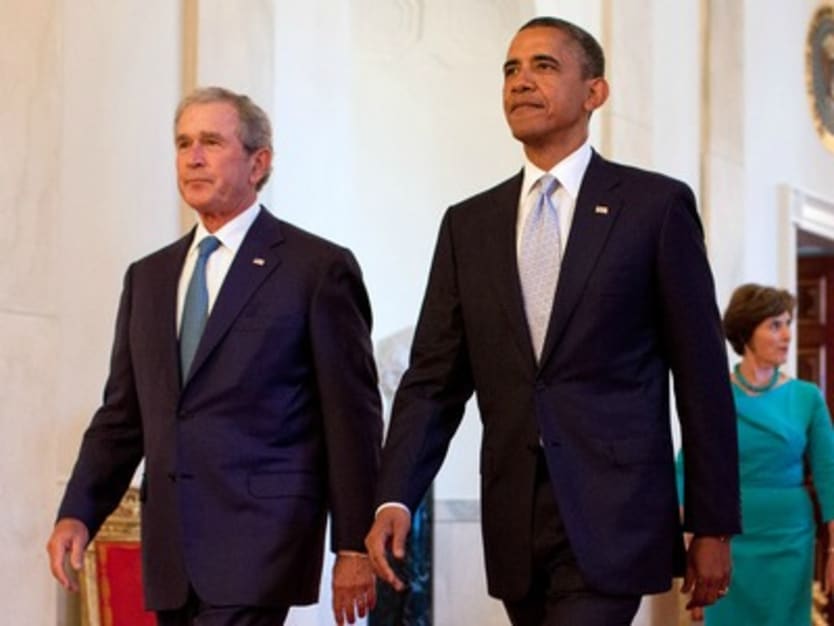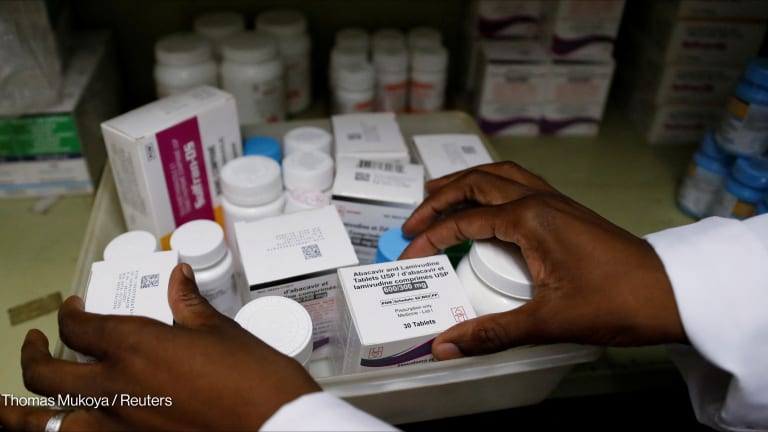
Over 25,000 delegates have begun converging upon Washington, D.C. for the 2012 International AIDS Conference. President Barack Obama – who has turned down an invitation to attend the event – lifted the 22-year-old ban on entry for those living with HIV in 2010, paving the way for the conference to return to the United States. Not since 1987 has the U.S. capital hosted the largest meeting of HIV/AIDS scientists, activists and policymakers. That year, while discussing U.S. plans for mandatory HIV testing of immigrants and prisoners, then Vice President George H.W. Bush was jeered on stage. At the time, America was simply not viewed as a leader in the global fight against the dreaded disease.
During this week’s conference, a much warmer reception awaits former U.S. President George W. Bush, U.S. Secretary of State Hillary Clinton, as well as her colleagues in the Obama administration. The U.S. President’s Emergency Plan for AIDS Relief, or PEPFAR, first adopted by the Bush administration in 2003 but since continued by Obama, is widely praised for transforming HIV/AIDS from a death sentence to a manageable chronic disease for millions. Representing nearly half of all foreign assistance for HIV/AIDS, PEPFAR has pumped tens of billions of dollars into prevention, treatment, and care programming in over 80 countries.
In late 2002, out of an estimated 5 million to 6 million people in need of HIV-fighting antiretroviral therapy in low- and middle-income countries, just 300,000 could count on the lifesaving treatment. In Africa, which continues to be hardest hit by HIV/AIDS, only 50,000 people had access to antiretroviral therapy.
Alluding to a “severe and urgent crisis,” Bush number two announced an unprecedented commitment to the fight against HIV/AIDS in his January 2003 State of the Union address. Later that year, Congress would authorize $15 billion through fiscal 2008 to create PEPFAR, representing a six-fold increase in U.S. bilateral spending on AIDS relief over the previous five-year period.
In 2008, the Lantos-Hyde Act reauthorized PEPFAR and stressed sustainability as a guiding principle for PEPFAR’s next phase. Lantos-Hyde also designated $39 billion through fiscal 2013 for both bilateral AIDS relief and contributions to the Global Fund to Fight AIDS, Tuberculosis and Malaria.
PEPFAR’s funding is concentrated in 31 countries which claim some of the highest disease burdens for HIV/AIDS, the majority of which are in Africa. The initiative also consolidated all U.S funding and activities for AIDS relief under a unified command structure led by the Office of the U.S. Global AIDS Coordinator at the Department of State. Since 2003, OGAC has coordinated HIV/AIDS programming from PEPFAR’s implementing agencies which include the U.S. Agency for International Development, the Centers for Disease Control and Prevention, and the National Institutes of Health.
PEPFAR’s 2003 authorization specified three targets for the 2008 deadline: (1) treating 2 million people, (2) preventing 7 million new infections, and (3) providing care to 10 million people, including orphans and vulnerable children. The initiative achieved each of these targets on schedule. A May 2012 Stanford University study estimated that, from 2004 to 2008, PEPFAR saved the lives of 740,000 people in nine African countries.
Efficiency and innovation can facilitate sustainability
In December 2011, Obama won applause from an audience of global AIDS advocates in Washington after announcing that he would raise PEPFAR’s antiretroviral therapy treatment target to 6 million by 2013. Earlier, the Obama administration had pledged that PEPFAR would treat four million by 2014, a target which was met in 2011. The administration is also bound by Lantos-Hyde’s 2014 targets for prevention and care: preventing 12 million new infections and providing care to 12 million people.
Yet, cautious optimism might best describe the mood of the crowd in Washington this week. For fiscal 2013, the Obama administration has requested $4.5 billion for bilateral AIDS relief programming, down 11 percent from current spending levels. As the Devex graphic shows, this would represent the third consecutive decrease in annual funding for PEPFAR.

Click here to view image in large size
Mitchell Warren, executive director of AVAC, previously known as the AIDS Vaccine Advocacy Coalition, contends that the administration’s ambitious targets for PEPFAR remain within reach despite the initiative’s dwindling budget.
“The good news is that there are increasing efficiencies of scale and additional ways to invest more wisely and PEPFAR has already benefited from that, and can benefit more…The proof will be in the increased number of people receiving treatment and prevention, but I think the Administration is certainly moving in the right direction,“ Warren told Devex.
Last November, Clinton revealed that lower drug costs and bulk purchasing, among other factors, have cut the cost of providing antiretroviral drugs and services by 70 percent per patient since 2004. The administration has also announced plans to focus investments on high-value, high-impact interventions including prevention of mother-to-child transmission and voluntary medical male circumcision. Studies have demonstrated significant cost savings for both of these interventions.
Recent advances in HIV/AIDS research and development, which have begun to blur the line between treatment and prevention, may provide yet another avenue for cost savings. In May 2011, an NIH study found that antiretroviral therapy reduces transmission to HIV-negative sexual partners by 96 percent. Earlier this month, the U.S. Food and Drug Administration approved a pill called Truvada, the first-ever drug to prevent HIV infection. NIH has since announced funding for research on a similar drug. The administration has added treatment as prevention, a term used to describe HIV prevention methods that use antiretroviral therapy, to its roster of priority interventions.
While these developments point to a path towards sustainability for PEPFAR in this budget-constrained environment, Warren cautions, “We will need sustained support for PEPFAR over the coming years if we are to have the impact we need to have on the epidemic.”
A bit less sanguine, Laurie Garrett, senior fellow for global health at the Council on Foreign Relations, asserted last year that it may take $30 billion to $45 billion in annual funding to speed up progress in AIDS prevention and treatment. In 2011, global spending on HIV/AIDS stood at $16.8 billion.
With only one year left before PEPFAR’s authorizing legislation expires, funding levels for the initiative are almost certain to fall short of the $39 billion authorized for global AIDS relief from fiscal 2009 to 2013. Even if Congress signs off on the president’s budget request in full (an unlikely occurrence if recent trends are any indication) lawmakers will have appropriated only $32.3 billion (83 percent) for both bilateral HIV/AIDS programming and Global Fund contributions over that five-year period. Contrast this situation with PEPFAR’s first phase $15 billion provision from fiscal 2004 to 2008 when Congress actually appropriated $3.3 billion (22 percent) more than authorized.
U.S. contributions to the Global Fund to Fight AIDS, Tuberculosis and Malaria, which have continued to rise under President Obama, are a relative bright spot for global AIDS advocates. The U.S., historically the leading donor to the multilateral financing organization, is likely to come within striking distance of fulfilling its pledge of $4 billion for the Global Fund from 2011 to 2013.
Tapping the private sector
Since its early days, PEPFAR took advantage of sufficient funding to aggressively pursue partnerships with both U.S. and international private sector organizations. These groups were called on to design and implement HIV/AIDS-related programming across all areas of intervention: prevention, treatment, and care.
Take a company like Crown Agents. Anticipating the resource and operational requirements necessary to get PEPFAR off the ground and keep it running, the U.K.-based firm, which specializes in procurement and logistics, joined 12 other private sector groups and NGOs to form the Partnership for Supply Chain Management. Today, on behalf of PEPFAR, the American-led legal entity procures and distributes antiretroviral drugs, HIV test kits, laboratory supplies and other products. To this day, officials of Crown Agents credit the program for facilitating its entry into the broader U.S. foreign assistance market.
According to Devex data, PEPFAR has provided a host of private sector opportunities. Despite a shrinking PEPFAR budget, as the chart above shows, global HIV/AIDS-related procurement opportunities with the U.S. government continue to grow. In 2011, U.S. government tenders for HIV/AIDS-related programming more than doubled from the previous year.

Click here to view image in large size
PEPFAR’s pledge to adopt more sustainable, country-owned programming – reinforced by the USAID Forward reform agenda – could actually be driving the increase in HIV/AIDS-related contract opportunities with the U.S. government. This commitment is shared by each of the Obama administration’s global development initiatives: the Global Health Initiative, the Global Climate Change Initiative and Feed the Future.
“U.S. support to combat HIV/AIDS will remain invaluable, but ensuring support is sustainable will require recipient governments take on the bulk of direct service delivery costs, particularly with regard to treatment, testing, and maintaining local health systems, over time,” argues a May 2012 Center for Global Development and Center for American Progress report titled “Engagement Amid Austerity.”
In preparation for an eventual handover of programming to host governments, technical assistance for government agencies in host countries is fast becoming a priority for PEPFAR investment. In 2011, more than one in 10 HIV/AIDS-related tenders issued by PEPFAR’s implementing agencies was focused on capacity building activities for government agencies in host countries. These included tenders for strengthening Mozambique’s National Institutes of Health and building the capacity of provincial medical offices in Zambia.
Since its 2008 reauthorization, PEPFAR has signed partnership frameworks with 19 countries – including leading partners South Africa, Kenya and Nigeria – aimed at strengthening country capacity, ownership and leadership. Saul Kornik, Chief Executive of Africa Health Placements, a USAID- and CDC-funded South African nongovernmental organization, advises PEPFAR implementing partners to “start engaging with host governments right from the outset to get their commitment to take programs over at the end of the PEPFAR funding cycle.”
As momentum builds for USAID Forward, which also aims to broaden the agency’s partner base, more local competition will likely accompany an increase in PEPFAR contract opportunities. USAID continues to be the lead U.S. aid agency issuing tenders for PEPFAR programming. Typically, local organizations have received USAID funding through subcontracts or “grants under contracts” mechanisms, which are managed by mostly U.S.-based development consultancies and NGOs. Under USAID Forward, the agency has pledged to ramp up direct engagement with local organizations.
Critics, including on Capitol Hill, charge that USAID’s push for direct engagement with local organizations must wait until the agency strengthens its oversight capabilities. In April, U.S. Global AIDS Coordinator Eric Goosby revealed that inefficient bureaucracies and delays due to long negotiations with host countries have left $1.5 billion in PEPFAR funding stuck in the pipeline for more than 18 months.
GHI may still shape PEPFAR programming
The extent to which this month’s closure of the GHI office will have an impact on the PEPFAR agenda remains to be seen. A collaborative leadership structure led by USAID, CDC and OGAC will now assume the mandate of ensuring that GHI principles – which emphasize country ownership, strategic coordination and integration, and women’s health – continue to be adopted across the U.S. global health architecture. Until its closure, plans were underway to transition the GHI office from the State Department to USAID which would then have become the lead agency for coordinating U.S. global health programming, except PEPFAR.
Some quarters believe GHI’s more comprehensive and holistic approach to global health may be lost.
“My question for the administration is how do you make those [GHI] principles stick without an initiative,” Center for Health and Gender Equity President Serra Sippel told Devex while calling the office shutdown “disturbing.”
At the same time, there are signs that PEPFAR implementing agencies are beginning to design programming in the context of overall well-being, putting prospective partners with well-rounded health expertise at a competitive advantage. As one example, CDC Director Tom Frieden testified before Congress in September 2010 that PEPFAR was concurrently and intentionally supporting tuberculosis programming.
“Fundamentally, it is a question of good management, and significant PEPFAR resources are going into improving the management of tuberculosis. Many of the countries in Africa had functioning tuberculosis-control systems, but when HIV came in and tripled the number of cases, they were overwhelmed,” said Frieden.
In 2011, Devex recorded that about 4 percent of HIV/AIDS-related tenders issued by the U.S. government also required significant expertise in tuberculosis management. These included tenders for systems strengthening for better HIV/TB patient outcomes in South Africa and strengthening the capacity of the Dominican Republic to provide HIV/STI/TB prevention services.
Next year, PEPFAR marks its 10th anniversary. This is no small feat for an initiative which a number of leading development experts initially feared would not ever get off the ground. The Obama administration’s apparent about-face on components of GHI is but one reminder that in Washington – especially as administrations come and go – ideas, initiatives, and funding often fade away all too quickly. The U.S. foreign aid industry is no exception. If PEPFAR can continue its commitment to innovation and partnership, however, visitors to the U.S. capital this week can still be hopeful over America’s leadership role in the fight against HIV/AIDS.
Lorenzo Piccio contributed to this report.
Read more:








